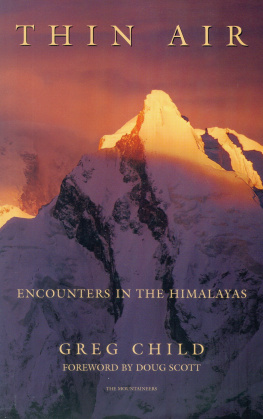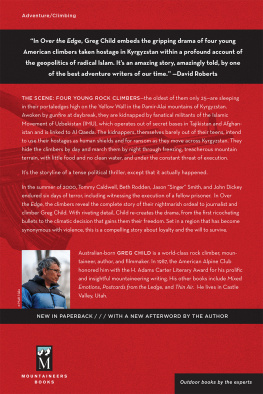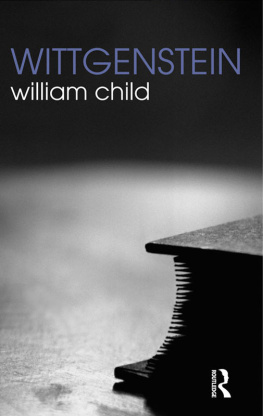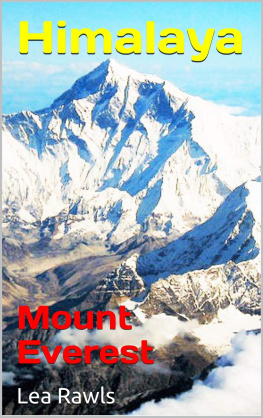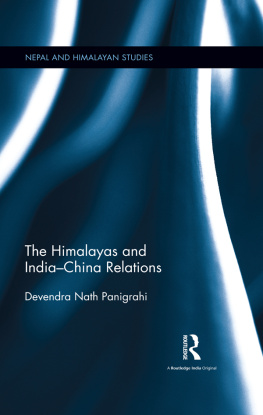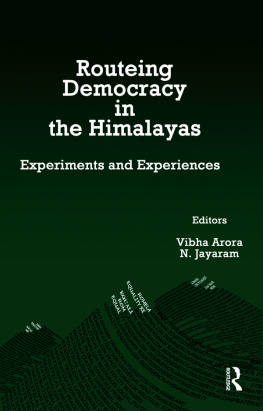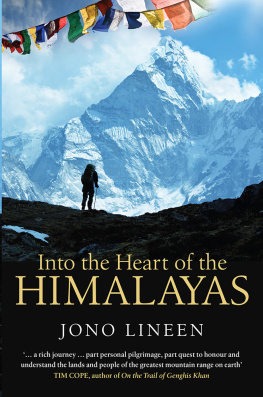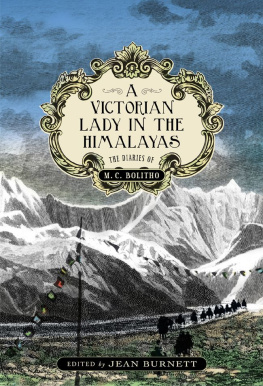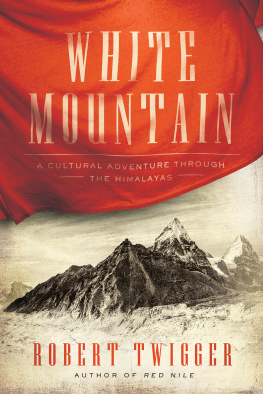Child - Thin Air: Encounters in the Himalayas
Here you can read online Child - Thin Air: Encounters in the Himalayas full text of the book (entire story) in english for free. Download pdf and epub, get meaning, cover and reviews about this ebook. City: Himalaya Mountains;Seattle;WA, year: 1998, publisher: The Mountaineers, genre: Non-fiction. Description of the work, (preface) as well as reviews are available. Best literature library LitArk.com created for fans of good reading and offers a wide selection of genres:
Romance novel
Science fiction
Adventure
Detective
Science
History
Home and family
Prose
Art
Politics
Computer
Non-fiction
Religion
Business
Children
Humor
Choose a favorite category and find really read worthwhile books. Enjoy immersion in the world of imagination, feel the emotions of the characters or learn something new for yourself, make an fascinating discovery.
- Book:Thin Air: Encounters in the Himalayas
- Author:
- Publisher:The Mountaineers
- Genre:
- Year:1998
- City:Himalaya Mountains;Seattle;WA
- Rating:5 / 5
- Favourites:Add to favourites
- Your mark:
- 100
- 1
- 2
- 3
- 4
- 5
Thin Air: Encounters in the Himalayas: summary, description and annotation
We offer to read an annotation, description, summary or preface (depends on what the author of the book "Thin Air: Encounters in the Himalayas" wrote himself). If you haven't found the necessary information about the book — write in the comments, we will try to find it.
Child: author's other books
Who wrote Thin Air: Encounters in the Himalayas? Find out the surname, the name of the author of the book and a list of all author's works by series.
Thin Air: Encounters in the Himalayas — read online for free the complete book (whole text) full work
Below is the text of the book, divided by pages. System saving the place of the last page read, allows you to conveniently read the book "Thin Air: Encounters in the Himalayas" online for free, without having to search again every time where you left off. Put a bookmark, and you can go to the page where you finished reading at any time.
Font size:
Interval:
Bookmark:



To Doctor Peter Thexton
 | Published by |
1988, 1998 by Greg Child
All rights reserved
First edition 1988. Second edition: first printing 1998, second printing 2004
No part of this book may be reproduced in any form, or by any electronic, mechanical, or other means, without permission in writing from the publisher.
Published simultaneously in Great Britain by Cordee, 3a DeMontfort Street, Leicester, England, LE1 7HD
Manufactured in the United States of America
Maps by Jennifer Shontz
All photographs by the author unless otherwise noted
Cover design by Helen Cherullo
Book design and layout by Jennifer Shontz
Cover photograph by Greg Child
Frontispiece: Greg Child on the west summit of Gasherbrum IV
ISBN ebook: 978-1-59485-690-7
Library of Congress Cataloging-in-Publication Data
Child, Greg.
Thin air: encounters in the Himalayas/Greg Child.2nd ed.
p.cm.
ISBN 0-89886-588-3
1. MountaineeringHimalaya Mountains. 2. Himalaya MountainsDescription and travel. I. Title.
GV199.44.H55C49 1998
796.52'2'095496dc21
98-20400
CIP
 Printed on recycled paper
Printed on recycled paper
It was in November of 1977 that I first met Greg Child. He had been lured to Great Britain by British climbers such as Guy Lee whom he had met in Californias Yosemite Valley. It was Guy who told me of Gregs prowess on the short hard rock climbs and long big wall routes of the Valley. Since those early days he has gone on to climb the huge monolith of El Cap, which dominates Yosemite, a dozen times. Today two of the most difficult ascents of that 3,000 ft big wallLost in America and Aurorawere pioneered by Greg with friends Randy Leavitt and Peter Mayfield.
Greg had begun his climbing career in much the same way as British climbers of the pre-mountain school/climbing wall generation. As a thirteen-year-old Sydney school boy, he and other local pupils such as Michael Law, Kim Carrigan and Chris Peisker went out onto local crags, picking up information here and there from older climbers and from a Boy Scouts Manual on how to climb. He served a long apprenticeship learning the hard way from his own experiences and mistakes, breaking a few bones in the process. Short day visits turned into weekend excursions and long holidays away from home to the now more popular climbing grounds such as Mount Arapiles and in the Blue Mountains. His 1977 Yosemite season was his first visit abroad.
Guy, like most other climbing friends, was busy working to pay off debts accrued while climbing during the summer so he recommended that Greg join me on a lecture tour in Scotland, making it obvious that I would enjoy Gregs company, not only for the climbing, but because Greg was a good lad. He was, for his age, remarkably self-contained and sure of himself, abrasive at times but with a twinkle in his eye and a huge disarming grin. I soon took to this warm-hearted Australian and thus our paths met and have continued to do so sporadically since on trips to the mountains.
So Greg set off with me to work the night, shifting place every day, but sometimes having days and nights off in between my lectures, to climb with me on snow and ice, and me with him on rock, such as at Dunkeld on a damp, greasy, steep and overhanging crag where he pulled me up and held me by my arms with trailing legs swinging about like a tadpoles tail, still recovering from a descent on the Ogre. What a fine rock climber: rock steady on an overhanging route of which he had no information and taking each move as it came, sure and certain of his ability. An hour later he was operating the projector in the Adam Smith Theatre, Kirkaldy, with me to one side of the screen giving the audience my version of the truth with regard to our ascent of the South West Face of Everest, hyped up with a little lecturers license.
It is a well known fact that if twelve climbers on an expedition, for example to the South West Face of Everest, were to write an expedition book and the reader was to read all twelve accounts, it would seem that the climbers had been on twelve different expeditions, at least in parts. Truth is seen to be relative to all the previous experiences of the seeker and each writer is seen to have a unique perception based upon where he was actually standing, his mood, his current interest, his imagination, his powers of observation and much else.
The mountains are seen to be a mirror reflecting our different and unique perceptions of them and all that happens on their flanks. The Indians of Gregs adopted North America knew this and more: The Universe is the mirror of the people and each person is a mirror to every other person. Every statement, observation and idea which Greg writes about here will surely affect his readers in different ways. In this book there is something for everyone, particularly as Greg is a keen observer with good recall of the situations in which he found himself, the mood of the mountains and time spent with the local people. I can vouch for this as I was with him on two out of the three expeditions he writes about here. He does not sit on the fence being all things to all men in an effort to pleasehe is far too honest a writer for that, but this is not to say he has not been influenced by other climbers and by the writings of such as Carlos Castaneda.
I have greatly appreciated the opportunity to relive these experiences. His book has evoked from me feelings of great sadness, but sometimes I have found myself laughing out loud at some of the incidents which happened on our trips: at others I have been gripped, holding back my breath, reliving the drama, strung out on a limb as we often were, battling with the elements and ourselves up in the thin air.
He is a powerful writer, concentrating in the main upon definite events rather than trying to achieve a grand Olympian view. In short he has expressed what he has seen rather than sought to impress us with that which he has not. All of us, I am sure, will be able to identify with Gregs story, through his early Himalayan apprenticeship, his coming of age on Lobsang Spire and Broad Peak and establishing himself as one of the up and coming great Himalayan mountaineers of the world with his ascent of Gasherbrum IV.
Doug Scott
Cumbria, April 1988
A decade has passed since Thin Air was first published in Britain and the United States, and I find it interesting now to reflect on the changes to my personal climbing landscape since I typed the last sentence of this book in 1988. Though I have never stopped climbing since the Himalayan expeditions to Shivling, Lobsang Spire, Broad Peak, and Gasherbrum IV, about which this book is concerned, I know that my attitudes toward climbing have changed. I cannot quite put my finger on exactly what those changes are, but in essence I no longer embrace the culture of risk taking as being integral to the climbing experience. That is not to say that I now condemn risk taking, or that I dont take risks on the climbs I have done in recent years or that I may do in the future. Risk is inherent to climbing; the two are indivisible. Embracing risk, however, is a different matter. I was younger when I wrote this book, and I was intrigued with the notion that I was involved in a sport in which the consequences of a mistake, or of just standing in the wrong place at the wrong moment, could be death. Being young, I romanticized that notion; treading the mental terrain of Himalayan climbing was exciting, cultish, meaningfulit still is. I would probably not do anything differently today on the climbs I describe in this book, but I think it is important to say that I now go about the psychological side of my climbing differently. And dont mistake these words as being an apology for risk: I am glad I did things as I did, and thought as I did on those climbs of the 1980s.
Font size:
Interval:
Bookmark:
Similar books «Thin Air: Encounters in the Himalayas»
Look at similar books to Thin Air: Encounters in the Himalayas. We have selected literature similar in name and meaning in the hope of providing readers with more options to find new, interesting, not yet read works.
Discussion, reviews of the book Thin Air: Encounters in the Himalayas and just readers' own opinions. Leave your comments, write what you think about the work, its meaning or the main characters. Specify what exactly you liked and what you didn't like, and why you think so.

